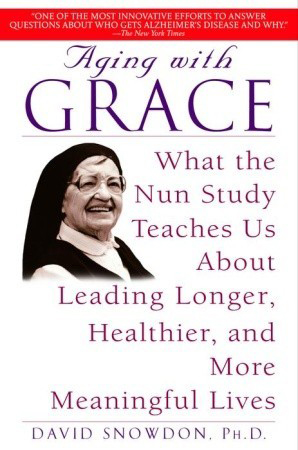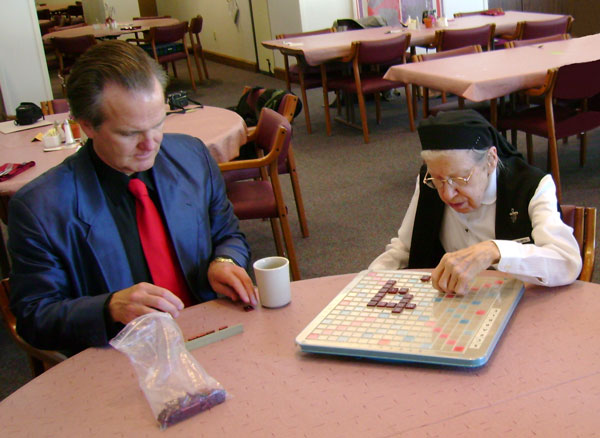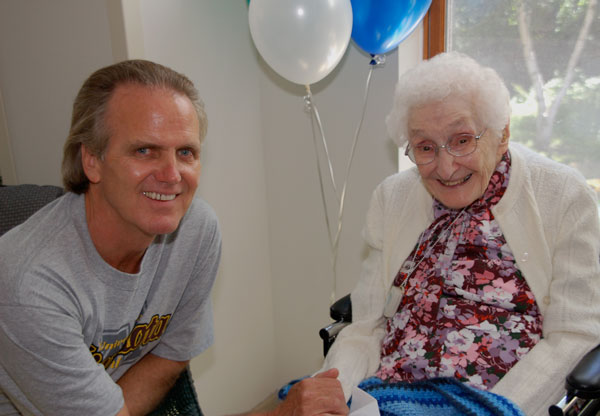The relevancy of “Aging with Grace” for today’s college students
 In 2018, one in three seniors will die from Alzheimer’s or another form of dementia according to the Alzheimer’s Association. This means that roughly 5.7 million Americans are living with Alzheimer’s. Sadly, this number is projected to rise to 14 million by 2050. Given the importance of Alzheimer’s within the health care field, Dr. Kristen Abbott-Anderson, Assistant Professor with the College of Allied Health & Nursing at Minnesota State University, Mankato, chose to utilize “Aging with Grace” by Dr. David Snowdon, in her Families in Transition 2 course work.
In 2018, one in three seniors will die from Alzheimer’s or another form of dementia according to the Alzheimer’s Association. This means that roughly 5.7 million Americans are living with Alzheimer’s. Sadly, this number is projected to rise to 14 million by 2050. Given the importance of Alzheimer’s within the health care field, Dr. Kristen Abbott-Anderson, Assistant Professor with the College of Allied Health & Nursing at Minnesota State University, Mankato, chose to utilize “Aging with Grace” by Dr. David Snowdon, in her Families in Transition 2 course work.
Why would this particular study and book still be relevant to college students 32 years after the study began? First, the study is not complete, it’s ongoing. Second, the likelihood that these students will come in contact with a patient or loved one suffering from Alzheimer’s or dementia is inevitable. College students benefit from Dr. Snowdon’s findings, not only through a thorough examination of his research techniques but also through awareness. The most significant outcome of the study was that the findings radically changed the way we view aging and living. These insights help students develop better end-of-life care possibilities for those with Alzheimer’s along with developing compassion and empathy.
 Dr. Snowdon’s unique study of 678 Catholic sisters from the School Sisters of Notre Dame, looked specifically at the aging process and the effects of Alzheimer’s disease within a specific population. Dr. Snowdon chose the sisters to study Alzheimer’s because he believed that Catholic sisters offered a number of advantages when investigating patterns and causes of diseases. First, they keep extensive membership lists and historical records (Snowdon 13). Second, they live similar lifestyles which enables researchers to make powerful comparisons between factors related to illness or health (Snowdon 14). According to Dr. Snowdon, “Nuns [have] even more similar histories. They do not smoke. They are celibate. They have similar jobs and income, and they receive similar health care for most of their lives. All of these factors reduce the confounding variables – such as poverty and lack of health care – that can cloud the meaning of data. Outside of a laboratory, it would be hard to find as pure an environment for research” (14).
Dr. Snowdon’s unique study of 678 Catholic sisters from the School Sisters of Notre Dame, looked specifically at the aging process and the effects of Alzheimer’s disease within a specific population. Dr. Snowdon chose the sisters to study Alzheimer’s because he believed that Catholic sisters offered a number of advantages when investigating patterns and causes of diseases. First, they keep extensive membership lists and historical records (Snowdon 13). Second, they live similar lifestyles which enables researchers to make powerful comparisons between factors related to illness or health (Snowdon 14). According to Dr. Snowdon, “Nuns [have] even more similar histories. They do not smoke. They are celibate. They have similar jobs and income, and they receive similar health care for most of their lives. All of these factors reduce the confounding variables – such as poverty and lack of health care – that can cloud the meaning of data. Outside of a laboratory, it would be hard to find as pure an environment for research” (14).
When Dr. Snowdon embarked on his relationship with the SSNDs, his initial aim was rather broad. He wanted to investigate aging, but he wasn’t entirely certain what he hoped to learn. While he tried to narrow down his research, he began making regular trips to Our Lady of Good Counsel in Mankato, Minnesota, hoping to find a focus. Initially, Dr. Snowdon simply took part in the lives of the sisters, spending time with the sisters living in the health care unit, eating meals with sisters in the cafeteria, playing a game of Scrabble or watching a Minnesota Twins game with them, as he worked out his ideas for a possible research project. Dr. Snowdon’s study took shape when he stumbled on the historical archives detailing not only the history of SSND but also, each individual sister’s life, which would allow him the unique ability to look backward and forward in time (24).  Initially, Dr. Snowdon’s research looked for “links between a sister’s level of education and her mental and physical abilities late in life” (33). This initial study developed into the 1986 “Nun Study,” where the primary question he hoped to answer was, “how the pathology in the brain relates to the expression of the symptoms of Alzheimer’s” (93). His question developed into a two-part study. The first part of the study involved the mental and physical evaluations of the sisters. The second, involved the donation of the sister’s brain upon death for a deeper look at pathology, including a laboratory examination of brain tissue samples for diagnostic or forensic purposes. In particular, the researchers wanted to look at the number and distribution of tangles within the brain itself, as these could be used to map the stages of disease (Snowdon 131). Those who were in control of each phase of the study did not meet to discuss their findings until after the pathology report had been completed. At that time, both groups came together to discuss their individual findings and what those findings meant for the study as a whole. In 2001, Dr. Snowdon published his findings in the book “Aging with Grace.”
Initially, Dr. Snowdon’s research looked for “links between a sister’s level of education and her mental and physical abilities late in life” (33). This initial study developed into the 1986 “Nun Study,” where the primary question he hoped to answer was, “how the pathology in the brain relates to the expression of the symptoms of Alzheimer’s” (93). His question developed into a two-part study. The first part of the study involved the mental and physical evaluations of the sisters. The second, involved the donation of the sister’s brain upon death for a deeper look at pathology, including a laboratory examination of brain tissue samples for diagnostic or forensic purposes. In particular, the researchers wanted to look at the number and distribution of tangles within the brain itself, as these could be used to map the stages of disease (Snowdon 131). Those who were in control of each phase of the study did not meet to discuss their findings until after the pathology report had been completed. At that time, both groups came together to discuss their individual findings and what those findings meant for the study as a whole. In 2001, Dr. Snowdon published his findings in the book “Aging with Grace.”
When Dr. Abbott-Anderson read “Aging with Grace” she kept thinking that even though this study started more than 20 years ago, there were so many pieces within the book that fit with the course she would be teaching for the first time in the fall of 2017. The course, Families in Transition 2, looks at families living in the context of chronic illness and end-of-life situations. The discussion on Alzheimer’s is threaded throughout the course.
Within Families in Transition 2, Dr. Abbott-Anderson asks her students to read “Aging with Grace” and to complete four reflection assignments based on the book. In the first reflection assignment, the students look at the ethical underpinnings of the research that was conducted. The second reflection looks at family, as they compare the lives of Sister Maria and Sister Deloris, who both grew up in Germany and had similar beginnings, but their lives took completely different paths. Sister Maria passed away from Alzheimer’s in 1996. Sister Deloris’ life was very different; it didn’t include Alzheimer’s. In 1996, Sister Deloris finished mission work in Kenya at the age of 80. Part of this second reflection requires students to choose one of the two sisters to do a genogram - a pictorial display of a person’s family relationships and medical history. Or an ecomap - a visual representation of an individual’s place in society with a series of lines connecting that individual to other individuals or networks of influence. Students then discuss what influences they see in the sister they selected. In the third reflection, the students look at the physiological issues that are discussed in the book.
The final reflection looks at the big picture. What does social engagement have to do with health and well-being? How does social support and spirituality play into the bigger picture? Students are asked to consider the idea of quality of life and its influence on the sister’s well-being and whether or not they exhibit the signs of Alzheimer’s within their lives.
When asked if Dr. Abbott-Anderson would continue to use “Aging with Grace” in her course, she said "absolutely." She would highly recommend this book to anyone who may be interested in Alzheimer’s because the study is as relevant today as it was 32 years ago. The study and the book have the potential to change lives for those who know someone suffering from Alzheimer’s, caregivers and anyone else who is affected by the disease. “The sisters need to know that this book is a living legacy, and it is impacting future nurse’s lives through awareness and empathy,” said Dr. Abbott-Anderson. “I think they are helping to prepare nurses who will be more compassionate about aging, about wellness and all of the other important aspects brought to life that this book discusses so well.”
To read more about recent documentaries in the news check out MPR News’ “Documentaries: ‘Heart and Soul’ and ‘Aging Gracefully.”